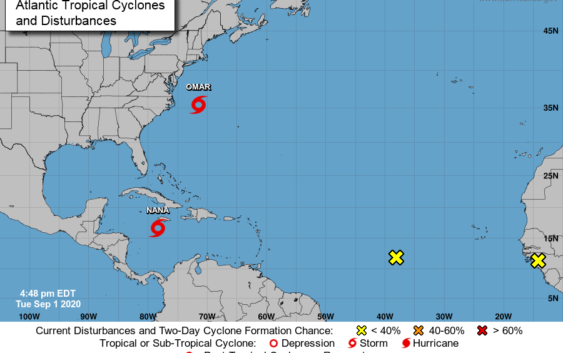- Weather Impact Alert: Brad Panovich updates severe weather risk on Sunday
- Big March storm system threatens US with tornadoes, blizzards and wildfire risk
- As city leaders consider expanding at-risk zone for wildfire damage, home builders say it could raise costs
- Is your neighborhood at high wildfire risk? | Here's how to check the city's wildfire risk map
- 'Be prepared now': Brad Panovich updates severe weather risk for Sunday
New tropical storm forms off North Carolina coast

Two named storms formed Tuesday, Nana and Omar, setting records as the earliest ’N’ and ’O’ named storms of a hurricane season
Two named storms of the hyperactive 2020 Atlantic hurricane season formed Tuesday afternoon, including one just off the Outer Banks.
Tropical Storm Omar was churning about 225 miles east of Cape Hatteras with sustained winds of 40 mph, as of 5 p.m. Tuesday. The storm was moving at 15 mph in an east-northeast direction away from the U.S. mainland. The storm isn’t expected to last very long, with forecasters from the National Hurricane predicting Omar could fizzle out by Thursday.
Omar was beaten by a few hours Tuesday by Tropical Storm Nana, which formed earlier in the afternoon southwest of Jamaica. Unlike Omar, Nana is expected to strengthen into a hurricane before making landfall in Central America.
Nana and Omar are the 14th and 15th named storms of the 2020 season.
Nana is the earliest “N” storm on record, beating 2005’s Nate by four days.
Omar comes even earlier. Ophelia, the previous holder, formed on Sept. 7, 2005. Like 2020, 2005 was a very active hurricane season – in fact the most active on record with 27 named storms. They included Hurricanes Emily, Katrina, Rita and Wilma, all of which reached Category 5 status.
The two new named storms aren’t the only weather patterns attracting attention in the Atlantic basin. The hurricane center is also tracking two tropical waves that have just started to cross the Atlantic from Africa.
The increase in activity in the tropics comes just days after Hurricane Laura, a Category 4 monster, made landfall in Louisiana after rapidly intensifying over the warm waters of the Gulf of Mexico.
The mainland United States has already seen three landfalling tropical systems this year – Tropical Storm Fay, which made landfall in New Jersey; Hurricane Isaias, which bludgeoned beaches in Southeastern North Carolina before traveling up the Interstate 95 corridor into the Mid-Atlantic and New England states; and the aforementioned Hurricane Laura.
The National Oceanic and Atmospheric Administration (NOAA) has warned coastal communities to prepare for an above-normal 2020 Atlantic hurricane season, with up to 19 named storms, of which up to 10 could become hurricanes. An average hurricane season sees 12 named storms, six of which are hurricanes.
Hurricane season runs through November.
Reporter Gareth McGrath can be reached at GMcGrath@Gannett.com.